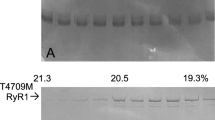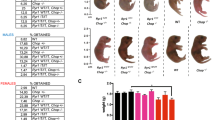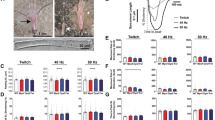Abstract
CONTRACTION of skeletal muscle is triggered by the release of Ca2+ from the sarcoplasmic reticulum (SR) after depolarization of transverse tubules1,2. The ryanodine receptor exists as a 'foot' protein in the junctional gap between the sarcoplasmic reticulum and the transverse tubule in skeletal muscle, and is proposed to function as a calcium-release channel during excitation-contraction (E-C) coupling3–6. Previous complementary DNA-cloning studies have defined three distinct subtypes of the ryanodine receptor in mammalian tissues, namely skeletal muscle, cardiac and brain types7–12. We report here mice with a targeted mutation in the skeletal muscle ryanodine receptor gene. Mice homozygous for the mutation die perinatally with gross abnormalities of the skeletal muscle. The contractile response to electrical stimulation under physiological conditions is totally abolished in the mutant muscle, although ryanodine receptors other than the skeletal-muscle type seem to exist because the response to caffeine is retained. Our results show that the skeletal muscle ryanodine receptor is essential for both muscular maturation and E-C coupling, and also imply that the function of the skeletal muscle ryanodine receptor during E-C coupling cannot be substituted by other subtypes of the receptor.
This is a preview of subscription content, access via your institution
Access options
Subscribe to this journal
Receive 51 print issues and online access
$199.00 per year
only $3.90 per issue
Buy this article
- Purchase on Springer Link
- Instant access to full article PDF
Prices may be subject to local taxes which are calculated during checkout
Similar content being viewed by others
References
Endo, M. Physiol. Rev. 57, 71–108 (1977).
Martonosi, A. N. Physiol. Rev. 64, 1240–1320 (1984).
Fleischer, S. & Inui, M. A. Rev. Biophys. biophys. Chem. 18, 333–364 (1989).
McPherson, P. S. & Campbell, K. P. J. biol. Chem. 268, 13765–13768 (1993).
Lai, F. A., Erickson, H. P., Rousseau, E., Liu, Q-Y. & Meissner, G. Nature 331, 315–319 (1988).
Block, B. A., Imagawa, T., Campbell, K. P. & Franzini-Armstrong, C. J. Cell Biol. 107, 2587–2600 (1988).
Takeshima, H. et al. Nature 339, 439–445 (1989).
Zorzato, F. et al. J. biol. Chem. 265, 2244–2256 (1990).
Otsu, K. et al. J. biol. Chem. 265, 13472–13483 (1990).
Nakai, J. et al. FEBS Lett. 271, 169–177 (1990).
Giannini, G., Clementi, E., Ceci, R., Marziali, G. & Sorrentino, V. Science 257, 91–94 (1992).
Hakamata, Y., Nakai, J., Takeshima, H. & Imoto, K. FEBS Lett. 312, 229–235 (1992).
Li, E., Bestor, T. H. & Jaenisch, R. Cell 69, 915–926 (1992).
Hasty, P. et al. Nature 364, 501–506 (1993).
Nabeshima, Y. et al. Nature 364, 532–535 (1993).
Gluecksohn-Waelsch, S. Science 142, 1269–1276 (1963).
Pai, A. C. Devl Biol. 11, 82–92 (1965).
Klaus, M. M., Scordilis, S. P., Rapalus, J. M., Briggs, R. T. & Powell, J. A. Devl Biol. 99, 152–165 (1983).
Beam, K. G., Knudson, C. M. & Powell, J. A. Nature 320, 168–170 (1986).
Chaudhari, N. J. biol. Chem. 267, 25636–25639 (1992).
Pai, A. C. Devl Biol. 11, 93–109 (1965).
Rios, E. & Brum, G. Nature 325, 717–720 (1987).
Tanabe, T., Beam, K. G., Powell, J. A. & Numa, S. Nature 336, 134–139 (1988).
Numa, S. et al. Cold Spring Harb. Symp. q. Biol. 40, 1–7 (1990).
Braum, T., Rudnicki, M. A., Arnold, H-H. & Jaenisch, R. Cell 71, 369–382 (1992).
Sanger, F., Nicklen, S. & Coulson, A. R. Proc. natn. Acad. Sci. U.S.A. 74, 5463–5467 (1977).
Rudnicki, M. A., Braun, T., Hinuma, S. & Jaenisch, R. Cell 71, 383–390 (1992).
Southern, E. M. Meth. Enzym. 68, 152–176 (1979).
Mansour, A. P. & Bradley, A. Cell 62, 1073–1085 (1990).
Saiki, R. K. et al. Science 239, 487–491 (1988).
Chirgwin, J. M., Przybyla, A. E., MacDonald, R. J. & Rutter, W. J. Biochemistry 18, 5294–5299 (1979).
Mishina, M. et al. Nature 321, 406–411 (1986).
Saito, A., Seiler, S., Chu, A. & Fleischer, S. J. Cell Biol. 103, 741–753 (1986).
Takeshima, H., Nishimura, S., Nishi, M., Ikeda, M. & Sugimoto, T. FEBS Lett. 322, 105–110 (1993).
Author information
Authors and Affiliations
Rights and permissions
About this article
Cite this article
Takeshima, H., lino, M., Takekura, H. et al. Excitation-contraction uncoupling and muscular degeneration in mice lacking functional skeletal muscle ryanodine-receptor gene. Nature 369, 556–559 (1994). https://doi.org/10.1038/369556a0
Received:
Accepted:
Issue Date:
DOI: https://doi.org/10.1038/369556a0
This article is cited by
-
In vivo RyR1 reduction in muscle triggers a core-like myopathy
Acta Neuropathologica Communications (2020)
-
Excitation-contraction coupling in skeletal muscle: recent progress and unanswered questions
Biophysical Reviews (2020)
-
Postsynaptic CaV1.1-driven calcium signaling coordinates presynaptic differentiation at the developing neuromuscular junction
Scientific Reports (2019)
-
Targeted mutagenesis of the ryanodine receptor by Platinum TALENs causes slow swimming behaviour in Pacific bluefin tuna (Thunnus orientalis)
Scientific Reports (2019)
-
STAC3 stably interacts through its C1 domain with CaV1.1 in skeletal muscle triads
Scientific Reports (2017)
Comments
By submitting a comment you agree to abide by our Terms and Community Guidelines. If you find something abusive or that does not comply with our terms or guidelines please flag it as inappropriate.



